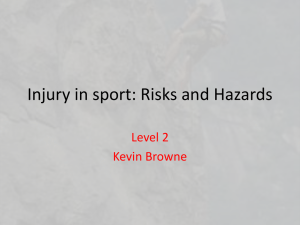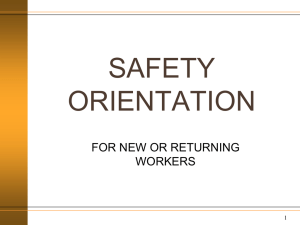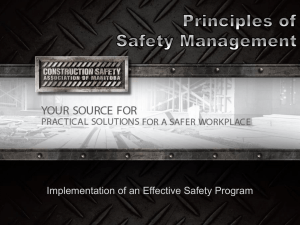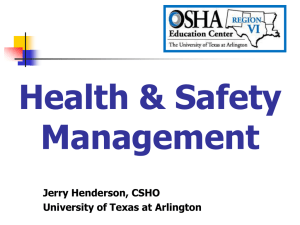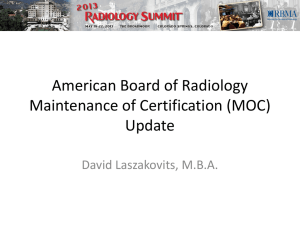Lecture Notes
advertisement
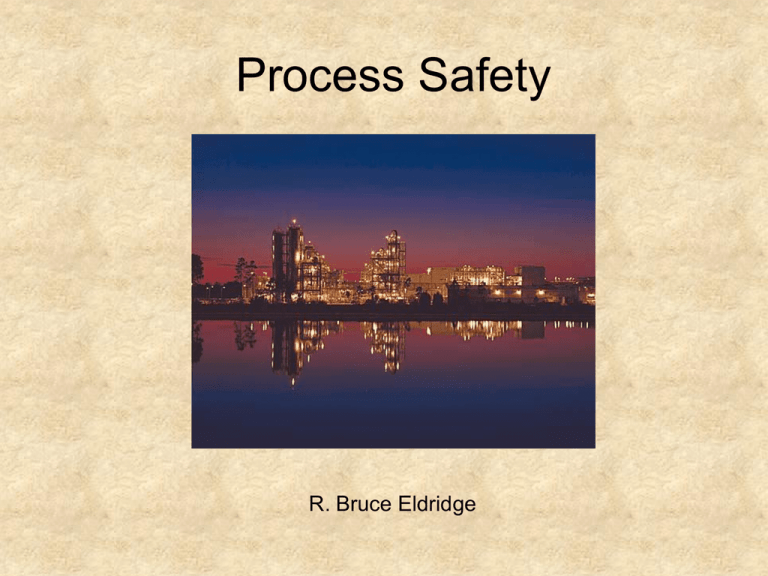
Process Safety R. Bruce Eldridge Incident Rates of Principle Industries (fatal accidents per million employees each year) • • • • • • • • Textile Chemical Furniture Industry Average Retail Railroad Construction Trucking 23 32 39 53 75 123 148 237 Safety Triangle 1 LOST TIME RECORDABLE FIRST AID 10 100 1000 What gets reported is just the tip of the iceberg….. the foundation that supports it is made up of behaviors and conditions that create risk. Why do we need it ? In 1970 Congress considered these annual figures • 14,000 workers were killed on the job • 2,500,000 workers were disabled from job-related accidents • 10 times as many lost work days from job-related disabilities as from strikes • Estimated new cases of occupational diseases totaled 300,000 The Occupational Safety & Health Act of 1970 was passed …. “…to assure so far as possible every working man and woman in the nation safe and healthful working conditions and to preserve our human resources” OSHA was created to… • Encourage employers and employees to reduce workplace hazards and to implement new or improve existing safety and health programs • Maintain a reporting and recordkeeping system to monitor job-related injuries and illnesses • Develop mandatory job safety and health standards and enforce them effectively (OSHA Regulations) The General Duty Clause states that each employer… “shall furnish…a place of employment which is free from recognized hazards that are causing or are likely to cause death or serious physical harm to his employees.” A Good Health & Safety Program accomplishes the following: • It “works” – is effective in reducing the frequency and severity of accidents • It addresses recognized hazards – whether or not they are regulated by government standards • It includes compliance with government agencies, insurance carriers, etc. Immediate Causes Work place layout 10% Inattention/lack of awareness 19% Work exposure to 13% Not following procedures 23% Protective systems 16% Tools & equipment 10% Use of protective methods 6% Use of tools 3% Who is driving? • Do we do this because OSHA requires it or because it’s the right thing to do? – – – – – – – – Injury reporting? Injury trending? Behavioral safety observations? Process hazard analysis? Job hazard analysis? Safety procedure development? Safety procedure audits? Emergency preparedness? Process Safety Management (PSM) • In February, 1992, OSHA issued a new standard called Process Safety Management of Highly Hazardous Chemicals (OSHA 1910.119) • The purpose of the PSM regulations is to define the requirements for “preventing or minimizing the consequences of catastrophic releases of toxic, reactive, flammable, or explosive chemicals.” Pre-PSM Major Disasters • 1984 Bhopal, India over 2000 deaths • 1989 Pasadena, TX 23 deaths 132 injuries • 1991 Sterlington, LA 8 deaths 128 injuries Post-PSM Major Disasters BP Deepwater Horizon 11 deaths 17 injuries BP Texas City 15 deaths 170 Injuries Post-PSM Major Disasters Pemex Refinery Explosion 30 deaths 42 Injuries Security Camera Video Elements of PSM • • • • • • • • • • • • • • Employee Participation Process Safety Information Process Hazard Analysis Operating Procedures Training Contractors Pre-Startup Safety Review Mechanical Integrity Safe Work Permits Management of Change Incident Investigation Emergency Planning & Response Compliance Audits Trade Secrets How incidents occur • Internal causes – Control failure – Equipment failure – Human error • External causes – Weather – Vehicle impact Anticipate what we can • Initiating event – Process upsets – Human error – External factors • Intermediate events – Propagating factors • Additional circumstances • Protective system failures • Incident outcome Process Hazard Analysis (PHA’s) • The process hazard analysis shall be appropriate to the complexity of the process – Hazard & Operability Study (HAZOP) – What-if – Checklist – Fault Tree Analysis – Failure Mode & Effects Analysis Process Hazard Analysis Shall Address: • • • • • • • The hazards of the process Previous incidents Engineering & administrative controls Consequences of failure Facility siting Human factors Evaluation of possible safety & health effects of failure of controls on workers More details… • The process hazard analysis shall be performed by a team with – Expertise in engineering – Expertise in process operations – At least one employee with experience and knowledge specific to the process being evaluated – At least one employee trained in process hazard analysis methodology More details… • The employer shall establish a system to promptly address, resolve and document the team’s findings, recommendations and the corrective actions taken • The process hazard analysis shall be revalidated at least every 5 years • All PHA’s and revalidations shall be retained by the employer for the life of the process What do we look at? • Process & Instrumentation Diagrams • Equipment Design Specifications • Material Hazards (MSDS) • Process Technology (operational design parameters) • Siting Criteria • Safety Equipment Design/Intent/Reliability HAZOP Studies & Guidewords • Used to ensure a thorough discussion of deviating from normal operating conditions • Area under study is broken into sections of manageable size • For each section the team goes through the list of guidewords • For each guideword the team discusses – – – – Causes Consequences Safeguards Recommendations Examples of Guidewords • • • • • • • • No flow More flow Less flow Reverse flow More pressure Less pressure More level Less level • • • • • • • • More temperature Less temperature Service failure Maintenance Chemical properties Contamination Human factors Previous incidents The thought process is… • What can cause the deviation? (List everything the team can think of) • For each cause, if it happens what are the consequences? • What safeguards do we have in place to prevent or control this situation? • Is it enough or do we recommend something more? Example for “No Flow” guideword • Cause - Block valves closed on cooling water supply and return to exchanger. • Consequence - Possible overpressure of tube side of exchanger if thermal expansion occurs. • Safeguards – Procedures in place that call for valves being left open Is the recommendation adequate? • Liquids can expand in volume approximately 1600 times upon vaporization 1 pint 4 55 gal drums Example for “No Flow” guideword • Recommendations – Investigate need for and install as necessary a relief valve on tube side of exchanger to prevent exchanger overpressure. • Corrective actions – Investigation complete, recommend thermal RV. Work order written to install 6/99. Work complete in field, 9/99. Recommendation closed. Other types of safety devices • • • • • • Alarms Trips Interlocks Analyzers Area monitors Containment The objective is to: • Anticipate ahead of time as many potential incidents and hazards as possible • Engineer out as many hazards as possible • Put safeguards in place to prevent incidents and control hazards when they can’t be engineered out Management of Change (MOC) • Employer will establish and implement written procedures to manage changes except for “replacements in kind” to process chemicals, technology, equipment and procedures; and changes to facilities that affect a covered process. MOC Procedures • The procedure shall assure the following considerations are addressed prior to any change: – Technical basis for the proposed change – Impact of change on safety & health – Modifications to operating procedures – Training of workers affected by change – Process information updated to reflect change A good MOC process addresses all of the following: • • • • • • • Equipment installed per design specifications Update Equipment Files/Data Books Update P&IDs and Process Flow Diagrams Update Lock Out / Tag Out Isolation list Update DCS Screens or Logic Update Material and Energy Balance Update Relief System Data A good MOC process addresses all of the following: • Hazard Review Completed • Hazard Review Safety Recommendations Resolved • HSE review impacts: PPE, Environmental, Regulatory • Update Chemical Information (MSDS) • Update Operating Procedures • Updating Operating Limits • Update Safety/Shutdown System Data A good MOC process addresses all of the following: • • • • • • • Update Training Materials Train Operating Personnel Train Maintenance Personnel Train Contractors Update Inspection Records Update Maintenance Records/Procedures Update Storehouse Stock Information Incidents resulting from poor Management of Change • Bhopal • Three mile island • Houston Chemical Complex The project engineer’s role • Ensure proper MOC is followed on your projects • Provide relevant information and expertise to process hazard analysis • Include safety devices in design and budget Our Responsibility to safety • Moral/Humanistic • Financial • Legal




